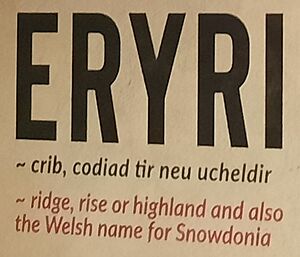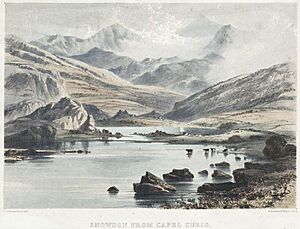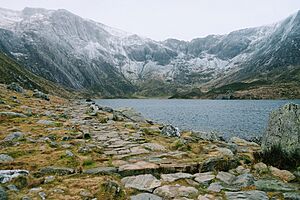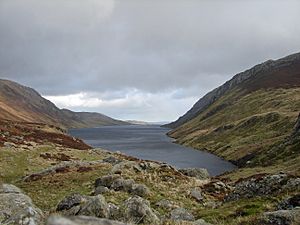Snowdonia facts for kids
Quick facts for kids Snowdonia |
|
|---|---|
| Eryri (Welsh) | |

View of Llyn Cwellyn from the Snowdon Ranger path
|
|
| Highest point | |
| Peak | Snowdon |
| Elevation | 1,085 m (3,560 ft) |
| Dimensions | |
| Area | 2,130 km2 (820 sq mi) |
| Geography | |
| Location | North Wales |
| Country | Wales, United Kingdom |
| Geology | |
| Orogeny | Caledonian |
| Age of rock | Cambrian and Ordovician |
| Type of rock | |
| Snowdonia National Park Eryri National Park Parc Cenedlaethol Eryri (Welsh) |
|
|
IUCN Category V (Protected Landscape/Seascape)
|
|
| Location | Conwy & Gwynedd (Wales) |
| Area | 823 sq mi (2,130 km2) |
| Established | 1951 |
| Governing body | Snowdonia National Park Authority |
 |
|
Snowdonia, or Eryri (pronounced [ɛrəri]), is a mountainous region and national park in North Wales. It contains all 15 mountains in Wales over 3000 feet high, including the country's highest, Snowdon (Yr Wyddfa), which is 1,085 metres (3,560 ft) tall. These peaks are all part of the Snowdon, Glyderau, and Carneddau ranges in the north of the region. The shorter Moelwynion and Moel Hebog ranges lie immediately to the south.
The national park has an area of 823 square miles (2,130 km2) (the fourth-largest in the UK), and covers most of central and southern Gwynedd and the western part of Conwy County Borough. This is much larger than the area traditionally considered Snowdonia, and in addition to the five ranges above includes the Rhinogydd, Cadair Idris, and Aran ranges and the Dyfi Hills. It also includes most of the coast between Porthmadog and Aberdyfi. The park was the first of the three national parks of Wales to be designated, in October 1951, and the third in the UK after the Peak District and Lake District, which were established in April and May 1951 respectively. The park received 3.89 million visitors in 2015.
Contents
Toponymy
The name "Snowdon" means "snow hill" and is derived from the Old English elements "snāw" and "dūn", the latter meaning 'hill'. "Snowdonia" is simply taken from the name of the mountain.
The origins of Eryri are less clear. Two popular interpretations are that the name is related to eryr, 'eagle', or that it means 'highlands' and is related to the Latin oriri ('to rise'). The latter is considered more correct, for eryri as a plural form means 'uplands', but it is not any direct form of the word eryr in the meaning 'eagle'.
Extent
Before the boundaries of the national park were designated, "Snowdonia" was generally used to refer to a smaller upland area of northern Gwynedd centred on the Snowdon massif. The national park covers an area more than twice that size, extending south into the Meirionnydd area.
This difference is apparent in books published before 1951. In George Borrow's 1907 Wild Wales he states that "Snowdon or Eryri is no single hill, but a mountainous region, the loftiest part of which [is] called Y Wyddfa", making a distinction between the summit of the mountain and the surrounding massif. The Mountains of Snowdonia by H. Carr & G. Lister (1925) defines "Eryri" as "composed of the two cantrefs of Arfon and Arllechwedd, and the two commotes of Nant Conwy and Eifionydd", which corresponds to Caernarfonshire with the exception of southwest Llŷn and the Creuddyn Peninsula. In Snowdonia: The National Park of North Wales (1949), F. J. North states that "When the Committee delineated provisional boundaries, they included areas some distance beyond Snowdonia proper".
National park
Snowdonia National Park, also known as Eryri National Park in English and Parc Cenedlaethol Eryri in Welsh, was established in October 1951. It was the third national park in the United Kingdom, following the Peak District and Lake District in April and May of the same year. It covers 827 square miles (2,140 km2) in the counties of Gwynedd and Conwy, and has 37 miles (60 km) of coastline.
The park is governed by the Snowdonia National Park Authority, which has 18 members: 9 appointed by Gwynedd, 3 by Conwy, and 6 by the Welsh Government to represent the national interest. The authority's main offices are at Penrhyndeudraeth.
The park authority used Snowdonia and Snowdon when referring to the national park and mountain in English until February 2023, when it resolved to primarily use the Welsh names, Eryri and Yr Wyddfa. There will be a transitional period of approximately two years in which the authority will continue to use the English names in parentheses — for example "Yr Wyddfa (Snowdon)" — where the context requires.
Unlike national parks in other countries, national parks in the UK are made up of both public and private lands under a central planning authority. The makeup of land ownership in the national park is as follows:
| Ownership type | Share (%) |
|---|---|
| Private | 69.9 |
| National Trust | 8.9 |
| National Park Authority | 1.2 |
| Natural Resources Wales | 17.5 |
| Water companies | 0.9 |
| Other | 1.6 |
More than 26,000 people live within the park, of whom 58.6% could speak Welsh in 2011. While most of the land is either open or mountainous land, there is a significant amount of agricultural activity within the park.
The national park does not include the town of Blaenau Ffestiniog, which forms a unique non-designated enclave within the park boundaries. The town was deliberately excluded from the park when it was established because of its slate quarrying industry. The boundaries of the Peak District National Park exclude the town of Buxton and its adjacent limestone quarries for a similar reason.
Geology

The geology of Snowdonia is key to the area's character. Glaciation during a succession of ice ages, has carved from a heavily faulted and folded succession of sedimentary and igneous rocks, a distinctive rocky landscape. The last ice age ended only just over 11,500 years ago, leaving a legacy of features attractive to visitors but which have also played a part in the development of geological science and continue to provide a focus for educational visits. Visiting Cwm Idwal in 1841 Charles Darwin realised that the landscape was the product of glaciation. The bedrock dates largely from the Cambrian and Ordovician periods with intrusions of Ordovician and Silurian age associated with the Caledonian Orogeny. There are smaller areas of Silurian age sedimentary rocks in the south and northeast and of Cenozoic era strata on the Cardigan Bay coast though the latter are concealed by more recent deposits. Low grade metamorphism of Cambrian and Ordovician mudstones has resulted in the slates, the extraction of which once formed the mainstay of the area's economy.
Geography
Mountains
The principal ranges of the traditional Snowdonia are the Snowdon massif itself, the Glyderau, the Carneddau, the Moelwynion and the Moel Hebog range. All of Wales' 3000ft mountains are to be found within the first three of these massifs and are most popular with visitors. To their south within the wider national park are the Rhinogydd and the Cadair Idris and Aran Fawddwy ranges. Besides these well-defined areas are a host of mountains which are less readily grouped though various guidebook writers have assigned them into groups such as the 'Arenigs', the 'Tarrens' and the 'Dyfi hills'.
Snowdon's summit at 1,085 metres (3,560 feet) is the highest in Wales and the highest in Britain south of the Scottish Highlands. At 905 metres (2,969 feet) Aran Fawddwy is the highest in Wales outside of northern Snowdonia; Cadair Idris, at 893 metres (2,930 feet), is next in line.

Rivers and lakes
Rivers draining the area empty directly into Cardigan Bay are typically short and steep. From north to south they include the Glaslyn and Dwyryd which share a common estuary, the Mawddach and its tributaries the Wnion and the Eden, the smaller Dysynni and on the park's southern margin the Dyfi. A series of rivers drain to the north coast. Largest of these is the Conwy on the park's eastern margin which along with the Ogwen drains into Conwy Bay. Further west the Seiont and Gwyrfai empty into the western end of the Menai Strait. A part of the east of the national park is within the upper Dee (Dyfrydwy) catchment and includes Bala Lake, the largest natural waterbody in Wales. A fuller list of the rivers and tributaries within the area is found at List of rivers of Wales.There are few natural waterbodies of any size in Wales; Snowdonia is home to most. Besides Bala Lake, a few lakes occupy glacial troughs including Llyn Padarn and Llyn Peris at Llanberis and Tal-y-llyn Lake south of Cadair Idris. Llyn Dinas, Llyn Gwynant, and Llyn Cwellyn to the south and west of Snowdon feature in this category as do Llyn Cowlyd and Llyn Ogwen on the margins of the Carneddau. There are numerous small lakes occupying glacial cirques owing to the former intensity of glacial action in Snowdonia. Known generically as tarns, examples include Llyn Llydaw, Glaslyn and Llyn Du'r Arddu on Snowdon, Llyn Idwal within the Glyderau and Llyn Cau on Cadair Idris.
There are two large wholly man-made bodies of water in the area, Llyn Celyn and Llyn Trawsfynydd whilst numerous of the natural lakes have had their levels artificially raised to different degrees. Marchlyn Mawr reservoir and Ffestiniog Power Station's Llyn Stwlan are two cases where natural tarns have been dammed as part of pumped storage hydro-electric schemes. A fuller list of the lakes within the area is found at List of lakes of Wales. In 2023, the park standardised its Welsh language lake names, to be also used in English.
Coast
The national park meets the Irish Sea coast within Cardigan Bay between the Dovey estuary in the south and the Dwyryd estuary. The larger part of that frontage is characterised by dune systems, the largest of which are Morfa Dyffryn and Morfa Harlech. These two locations have two of the largest sand/shingle spits in Wales. The major indentations of the Dovey, the Mawddach and Dwyryd estuaries, have large expanses of intertidal sands and coastal marsh which are especially important for wildlife: see #Natural history. The northern tip of the national park extends to the north coast of Wales at Penmaen-bach Point, west of Conwy, where precipitous cliffs have led to the road and railway negotiating the spot in tunnels.
Settlements
There are only three towns within the park boundary, though there are several more immediately beyond it. Dolgellau is the most populous followed by Bala on the eastern boundary and then Harlech overlooking Tremadog Bay. More populous than these is the town of Blaenau Ffestiniog, which is within an exclave, that is to say it is surrounded by the national park but excluded from it, whilst the towns of Tywyn and Barmouth on the Cardigan Bay coast are within coastal exclaves. Llanrwst in the east, Machynlleth in the south and Porthmadog and Penrhyndeudraeth in the west are immediately beyond the boundary but still identified with the park; indeed the last of these hosts the headquarters of the Snowdonia National Park Authority. Similarly the local economies of the towns of Conwy, Bethesda, and Llanberis in the north are inseparably linked to the national park as they provide multiple visitor services. The lower terminus of the Snowdon Mountain Railway is at Llanberis. Though adjacent to it, Llanfairfechan and Penmaenmawr are less obviously linked to the park.
There are numerous smaller settlements within the national park: prominent amongst these are the eastern 'gateway' village of Betws-y-Coed, Aberdyfi on the Dovey (Dyfi) estuary and the small village of Beddgelert each of which attract large numbers of visitors. Other sizeable villages are Llanuwchllyn at the southwest end of Bala Lake (Llyn Tegid), Dyffryn Ardudwy, Corris, Trawsfynydd, Llanbedr, Trefriw and Dolwyddelan.
Transport
Roads
Six primary routes serve Snowdonia, the busiest of which is the A55, a dual carriageway which runs along the north coast and provides strategic road access to the northern part of the national park. The most important north–south route within the park is the A470 running from the A55 south past Betws-y-Coed to Blaenau Ffestiniog to Dolgellau. It exits the park a few miles to the southeast near Mallwyd. From Dolgellau, the A494 runs to Bala whilst the A487 connects with Machynlleth. The A487 loops around the northwest of the park from Bangor via Caernarfon to Porthmadog before turning in land to meet the A470 east of Maentwrog. The A5 was built as a mail coach road by Thomas Telford between London and Holyhead; it enters the park near Pentrefoelas and leaves it near Bethesda. Other A class roads provide more local links; the A493 down the Dovey valley from Machynlleth and up the coast to Tywyn then back up the Mawddach valley to Dolgellau, the A496 from Dolgellau down the north side of the Mawddach to Barmouth then north up the coast via Harlech to Maentwrog. The A4212 connecting Bala with Trawsfynydd is relatively modern having been laid out in the 1960s in connection with the construction of Llyn Celyn. Three further roads thread their often twisting and narrow way through the northern mountains; A4085 links Penrhyndeudraeth with Caernarfon, the A4086 links Capel Curig with Caernarfon via Llanberis and the A498 links Tremadog with the A4086 at Pen-y-Gwryd. Other roads of note include that from Llanuwchllyn up Cwm Cynllwyd to Dinas Mawddwy via the 545 metres (1,788 feet) high pass of Bwlch y Groes, the second highest tarmacked public road in Wales and the minor road running northwest and west from Llanuwchllyn towards Bronaber via the 531 metres (1,742 feet) high pass of Bwlch Pen-feidiog.
Railways

- The double track North Wales Coast Line passes along the northern boundary of the park between Conwy and Bangor, briefly entering it at Penmaen-bach Point, where it is in a tunnel. Stations serve the communities of Conwy, Penmaenmawr, Llanfairfechan and Bangor.
- The single-track Conwy Valley Line runs south from Llandudno Junction, and enters the park north of Betws-y-coed, which is served by a station, then continues west up the Lledr valley by way of further stations at Pont-y-pant, Dolwyddelan and Roman Bridge. After passing through a tunnel, the passenger line now terminates at Blaenau Ffestiniog railway station, where it connects with the Ffestiniog Railway.
- Before 1961 the route continued as the Bala and Ffestiniog Railway via Trawsfynydd to Bala, joining another former route along the Dee valley which ran southwest via Dolgellau to join the still extant coastal Cambrian Line south of Barmouth.
- The Pwllheli branch of the Cambrian Line splits from the Aberystwyth branch at Dovey Junction and continues northwards via stations at Aberdovey, Tywyn, Tonfanau, Llwyngwril, Fairbourne and Morfa Mawddach to Barmouth where it crosses the Mawddach estuary by the Grade II* listed wooden Barmouth Bridge, a structure which also provides for walkers and cyclists. Continuing northwards, further stations serve Llanaber, Tal-y-bont, Dyffryn Ardudwy, Llanbedr, Pensarn and Llandanwg before reaching Harlech. Tygwyn, Talsarnau and Llandecwyn stations are the last before the line exits the park as it crosses the Dwyryd estuary via Pont Briwet and turns westwards bound for Pwllheli via Penrhyndeudraeth, Porthmadog and Criccieth.
Many sections of dismantled railway are now used by walking and cycling routes and are described elsewhere. The Bala Lake Railway is a heritage railway which has been established along a section of the former mainline route between Bala and Llanuwchllyn. Other heritage railways occupy sections of former mineral lines, often narrow gauge and are described in a separate section.
Buses
The national park is served by a growing bus network, branded Sherpa'r Wyddfa (formerly Snowdon Sherpa). Together with the TrawsCymru network of buses this provides a car-free option to tourists and locals wishing to travel across the National Park.
The network was relaunched in July 2022 with a new brand, Sherpa'r Wyddfa, to reflect the National Park's new push for the promotion of Welsh place names. As such the publicity and websites for the newly branded service only use these Welsh names, even for English language users.
Climate
Snowdonia is one of the wettest parts of the United Kingdom; Crib Goch in Snowdonia is the wettest spot in the United Kingdom, with an average rainfall of 4,473 millimetres (176.1 in) a year over the 30-year period prior to the mid-2000s. (There is a rainfall gauge at 713 metres (2,339 feet)on the slopes below Crib Goch.)
History
The earliest evidence for human occupation of the area dates from around 4000–3000 BC with extensive traces of prehistoric field systems evident in the landscape. Within these are traces of irregular enclosures and hut circles. There are burial chambers of Neolithic and Bronze Age such as Bryn Cader Faner and Iron Age hillforts such as Bryn y Castell near Ffestiniog.
The region was finally conquered by the Romans by AD 77–78. Remains of Roman marching camps and practice camps are evident. There was a Roman fort and amphitheatre at Tomen y Mur. Roads are known to have connected with Segontium (Caernarfon) and Deva Victrix (Chester) and include the northern reaches of Sarn Helen.
There are numerous memorial stones of Early Christian affinity dating from the post-Roman period. The post-Roman hillfort of Dinas Emrys also dates to this time. Churches were introduced to the region in the 5th and 6th centuries. Llywelyn the Great and Llywelyn ap Gruffudd had various stone castles constructed to protect their borders and trade routes. Edward I built several castles around the margins including those at Harlech and Conwy for military and administrative reasons. Most are now protected within a World Heritage Site. Some of Snowdonia's many stone walls date back to this period too. In the Middle Ages, the title Prince of Wales and Lord of Snowdonia (Tywysog Cymru ac Arglwydd Eryri) was used by Llywelyn ap Gruffudd; his grandfather Llywelyn Fawr used the title Prince of north Wales and Lord of Snowdonia.
The 18th century saw the start of industrial exploitation of the area's resources, assisted by the appearance in the late part of the century of turnpike trusts making it more accessible. The engineer Thomas Telford left a legacy of road and railway construction in and around Snowdonia. A new harbour at Porthmadog linked to slate quarries at Ffestiniog via a narrow gauge railway. At its peak in the 19th century the slate industry employed around 12,000 men. A further 1000 were employed in stone quarrying at Graiglwyd and Penmaenmawr. Mining for copper, iron and gold was undertaken during the 18th and 19th centuries, leaving a legacy of mine and mill ruins today. Ruins of the gold industry are found at Cefn Coch on the Dolmelynllyn estate.
The Snowdonia Society is a registered charity formed in 1967; it is a voluntary group of people with an interest in the area and its protection.
Amory Lovins led the successful 1970s opposition to stop Rio Tinto digging up the area for a massive mine.
Natural history
The park's entire coastline is a Special Area of Conservation, which runs from the Llŷn Peninsula down the mid-Wales coast, the latter containing valuable sand dune systems.
The park's natural forests are of the mixed deciduous type, the commonest tree being the Welsh oak. Birch, ash, mountain-ash and hazel are also common. The park also contains some large (planted) coniferous forested areas such as Gwydir Forest near Betws-y-Coed, although some areas, once harvested, are now increasingly being allowed to regrow naturally.
Flora
Northern Snowdonia is the only place in Britain where the Snowdon lily (Gagea serotina), an arctic–alpine plant, is found and the only place in the world where the Snowdonia hawkweed Hieracium snowdoniense grows.
One of the major problems facing the park in recent years has been the growth of Rhododendron ponticum. This fast-growing invasive species has a tendency to take over and stifle native species. It can form massive towering growths and has a companion fungus that grows on its roots producing toxins that are poisonous to any local flora and fauna for a seven-year period after the Rhododendron infestations have been eradicated. As a result, there are a number of desolate landscapes.
Fauna
Mammals in the park include otters, polecats, feral goats, and pine martens. Birds include raven, red-billed chough, peregrine, osprey, merlin and the red kite. The rainbow-coloured Snowdon beetle (Chrysolina cerealis) is only found in northern Snowdonia.
Conservation designations
Snowdonia has a particularly high number of protected sites in respect of its diverse ecology; nearly 20% of its total area is protected by UK and European law. Half of that area was set aside by the government under the European Habitats Directive as a Special Area of Conservation. There are a large number of Sites of special scientific interest (or 'SSSIs'), designated both for fauna and flora but also in some cases for geology. Nineteen of these sites are managed as national nature reserves by Natural Resources Wales. The park also contains twelve Special Areas of Conservation (or 'SACs'), three Special Protection Areas (or 'SPAs') and three Ramsar sites. Some are wholly within the park boundaries, others straddle it to various degrees.
Sites of Special Scientific Interest
There are numerous SSSIs within the park, the most extensive of which are Snowdonia, Migneint-Arenig-Dduallt, Morfa Harlech, Rhinog, Berwyn, Cadair Idris, Llyn Tegid, Aber Mawddach / Mawddach Estuary, Dyfi, Morfa Dyffryn, Moel Hebog, Coedydd Dyffryn Ffestiniog and Coedydd Nanmor.
National nature reserves
The following NNRs are either wholly or partly within the park: Allt y Benglog, Y Berwyn (in multiple parts), Cader Idris, Ceunant Llennyrch, Coed Camlyn, Coed Cymerau, Coed Dolgarrog, Coed Ganllwyd, Coed Gorswen, Coed Tremadog, Coedydd Aber, Coedydd Maentwrog (in 2 parts), Coed y Rhygen, Cwm Glas Crafnant, Cwm Idwal, Hafod Garregog, Morfa Harlech, Rhinog and Snowdon.
Special Areas of Conservation
The twelve SACs are as follows: Snowdonia SAC which covers much of the Carneddau, Glyderau, and the Snowdon massif, Afon Gwyrfai a Llyn Cwellyn, Corsydd Eifionydd / Eifionydd Fens (north of Garndolbenmaen), the Coedydd Derw a Safleoedd Ystlumod Meirion / Meirionydd Oakwoods and Bat Sites - a series of sites between Tremadog, Trawsfynydd, and Ffestiniog and Beddgelert and extending up the Gwynant. It also includes many of the oakwoods of the Mawddach and its tributaries. Afon Eden – Cors Goch Trawsfynydd, Rhinog, Cadair Idris (in 2 parts), Migneint-Arenig-Dduallt, River Dee and Afon Dyfrdwy a Llyn Tegid (Wales), Mwyngloddiau Fforest Gwydir / Gwydyr Forest Mines (north of Betws-y-Coed) and a part of the Berwyn a Mynyddoedd De Clwyd / Berwyn and South Clwyd Mountains SAC. The Pen Llyn a'r Sarnau / Lleyn Peninsula and the Sarnau SAC covers the entire Cardigan Bay coastline of the park and the sea area and extends above the high water mark at Morfa Harlech, Mochras and around the Dovey and Mawddach estuaries.
Special Protection Areas
The three SPAs are Dovey Estuary / Aber Dyfi (of which a part is within the park), Berwyn (of which a part is within the park) and Migneint-Arenig-Dduallt.
Ramsar sites
The three designated Ramsar sites are the Dyfi Biosphere (Cors Fochno and Dyfi), Cwm Idwal and Llyn Tegid (Bala Lake).
Economy
The area's economy was traditionally centred upon farming and from the early 19th century increasingly on mining and quarrying. Tourism has become an increasingly significant part of Snowdonia's economy during the 20th and 21st centuries.
Hill farming
The extensive farming of sheep remains central to Snowdonia's farming economy.
Forestry
Significant sections of the park were afforested during the 20th century for timber production. Major conifer plantations include Dyfi Forest, Coed y Brenin Forest between Dolgellau and Trawsfynydd, Penllyn Forest south of Bala, Beddgelert Forest and Gwydyr (or Gwydir) Forest near Betws-y-Coed which is managed as a forest park by Natural Resources Wales.
Slate industry
The region was once the most important producer of slate in the world. Some production continues but at a much reduced level from its peak. The park boundaries are drawn such that much of the landscape affected by slate quarrying and mining lies immediately outside of the designated area.
Energy production
Construction of a nuclear power station beside Llyn Trawsfynydd began in 1959 with the first power produced in 1965. The site was operational until 1991 though it continues as an employer during its decommissioning phase. Pumped storage hydroelectric schemes are in operation at Llanberis and Ffestiniog.
Tourism
Research indicates that there were 3.67 million visitors to Snowdonia National Park in 2013, with approximately 9.74 million tourist days spent in the park during that year. Total tourist expenditure was £433.6 million in 2013.
Hiking
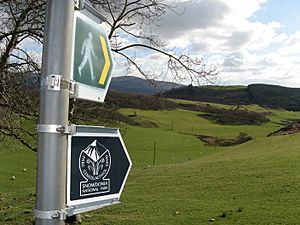
Many of the hikers in the area concentrate on Snowdon itself. It is regarded as a fine mountain, but at times gets very crowded; in addition the Snowdon Mountain Railway runs to the summit.
The other high mountains with their boulder-strewn summits as well as Tryfan, one of the few mountains in the UK south of Scotland whose ascent needs hands as well as feet are also very popular. However, there are also some spectacular walks in Snowdonia on the lower mountains, and they tend to be relatively unfrequented. Among hikers' favourites are Y Garn (east of Llanberis) along the ridge to Elidir Fawr; Mynydd Tal-y-Mignedd (west of Snowdon) along the Nantlle Ridge to Mynydd Drws-y-Coed; Moelwyn Mawr (west of Blaenau Ffestiniog); and Pen Llithrig y Wrach north of Capel Curig. Further south are Y Llethr in the Rhinogydd, and Cadair Idris near Dolgellau.
The park has 1,479 miles (2,380 km) of public footpaths, 164 miles (264 km) of public bridleways, and 46 miles (74 km) of other public rights of way. A large part of the park is also covered by right to roam laws.
Recreational routes
The Wales Coast Path runs within the park between Machynlleth and Penrhyndeudraeth, save for short sections of coast in the vicinity of Tywyn and Barmouth which are excluded from the park. It touches the park boundary again at Penmaen-bach Point on the north coast. An inland alternative exists between Llanfairfechan and Conwy, wholly within the park. The North Wales Path, which predates the WCP, enters the park north of Bethesda and follows a route broadly parallel to the north coast visiting Aber Falls and the Sychnant Pass before exiting the park on the descent from Conwy Mountain. The Cambrian Way is a long-distance trail between Cardiff and Conwy that stays almost entirely within the national park from Mallwyd northwards. It was officially recognised in 2019, and is now depicted on Ordnance Survey maps.
Use of Eryri in English
The use of the English names for the area has been divisive, with an increase in protests against their use since 2020; these led to the national park authority deciding to use Welsh names as far as legally possible in November 2022. An early example of pressure to deprecate Snowdon and Snowdonia was a 2003 campaign by Cymuned, inspired by campaigns to refer to Ayers Rock as Uluru and Mount Everest as Qomolangma.
In 2020 an e-petition calling for the removal of the English names was put forward to the Senedd, but rejected as responsibility lies with the national park authority. In 2021 an e-petition on the same topic attracted more than 5,300 signatures and was presented to the national park authority.
On 28 April 2021 Gwynedd councillor John Pughe Roberts put forward a motion to use the Welsh names exclusively, calling this a "question of respect for the Welsh language". The motion was not considered, but was deferred, as the national park authority had already appointed a "Welsh Place Names Task and Finish Group" to investigate the issue. Of course the park authority cannot compel other bodies or individuals to stop using the English names, and the proposals have faced some criticism.
In May 2021, following the dismissal of the motion, YouGov conducted a poll on Snowdon's name. 60% of Welsh adults supported the English name Snowdon, compared to 30% wanting the Welsh name Yr Wyddfa. Separating by language, 59% of Welsh speakers preferred the Welsh name, but 37% of these still wanted Snowdon to be used as well. 69% of non-Welsh speakers firmly supported Snowdon as the Mountain's name. The proposals to rename Snowdon are usually accompanied with proposals to rename Snowdonia.
On 16 November 2022, Members of the Snowdonia National Park Authority committee voted to use the Welsh names Yr Wyddfa and Eryri to refer to the mountain and the national park, rather than the English names, in materials produced by the authority. The national park authority described the decision as "decisive action" and the authority's head of culture heritage stated that Welsh place names were part of the area's "special qualities" and that other public bodies, English-language press and filming companies have used the Welsh-language names. Before the decision the park had already prioritised the Welsh names by using them first and giving the English names in parentheses. The name "Snowdonia" cannot be abandoned entirely, as it is set in law and so must be used in statutory documents. The authority announced a review of the authority's branding in 2023 to adapt to the new approach to Welsh place names.



